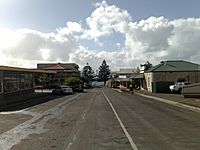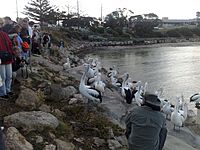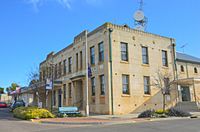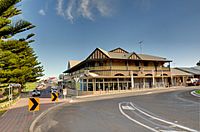Kingscote, South Australia facts for kids
Quick facts for kids KingscoteSouth Australia |
|||||||||||||||
|---|---|---|---|---|---|---|---|---|---|---|---|---|---|---|---|

Dauncey Street
|
|||||||||||||||
| Population | 1,790 (2016 census) | ||||||||||||||
| Established | 1836 | ||||||||||||||
| Postcode(s) | 5223 | ||||||||||||||
| Location | 119 km (74 mi) south-west of Adelaide | ||||||||||||||
| LGA(s) | Kangaroo Island Council | ||||||||||||||
| Region | Fleurieu and Kangaroo Island | ||||||||||||||
| County | Carnarvon | ||||||||||||||
| State electorate(s) | Mawson | ||||||||||||||
| Federal Division(s) | Mayo | ||||||||||||||
|
|||||||||||||||
|
|||||||||||||||
| Footnotes | Location Climate Adjoining localities |
||||||||||||||
Kingscote is a town in South Australia on Kangaroo Island. It's about 119 kilometers (74 miles) southwest of Adelaide, the state capital. Kingscote is special because it's the oldest European settlement in South Australia. It's also the biggest town on Kangaroo Island. In 2016, about 1,790 people lived there. Kingscote is a popular place for tourists and the main center for the local government and communications. It's also home to a colony of the world's smallest penguins, called the Australian little penguin.
The town has its own airport, Kingscote Airport. You can catch passenger flights there with two different airlines.
Contents
History of Kingscote
Kingscote was the very first official European settlement in South Australia. The South Australian Company started their colony here at Reeves Point on July 27, 1836. The first settlers arrived on a ship called the Duke of York. The town was named after Henry Kingscote, who was one of the company's founders.
Some people thought Kingscote might become the capital city of South Australia. However, Kangaroo Island didn't have enough resources to support such a large community. So, about six months later, the South Australian Company moved to Adelaide after finding a better location.
You can learn about the area's history at the museum in Hope Cottage. This cottage is one of the oldest houses in Kingscote, built around 1850. It was part of a group of three cottages named Faith, Hope, and Charity. Faith has since been taken down.
In 1925, Joyce Debenham Seager became the only doctor on the island. She set up the first temporary hospital and traveled by horse to visit her patients.
A very old mulberry tree was planted in 1836 at Reeves Point. It still grows fruit today! Reeves Point is now a protected place on the Australian Heritage Places List.
The Kingscote town you see today is just south of the original settlement at Reeves Point. This area was first known as Queenscliffe. That's where the Queenscliffe Hotel in Dauncey Street gets its name.
Important Historic Places
Kingscote has several places listed on the South Australian Heritage Register. These are important historical sites:
- Hope Cottage Museum: A historic cottage now used as a museum.
- The Bluff Cottage: Another old cottage with historical value.
- Barrett's Store: An old store building.
- Reeves Point Settlement Site: This is where the first official settlement in South Australia began.
- Old Government Quarry: An old quarry site.
What Kingscote Offers
Kingscote has many useful facilities for its residents. There's a school that teaches students from reception (kindergarten) all the way to year 12. The town also has a hospital, a supermarket, a post office, and government offices. It's the main administrative center for the Kangaroo Island Council. Their offices have recently been updated.
For fun and sports, Kingscote has a sports center. Next to it, you'll find an oval for games and courts for netball.
The Foreshore and Jetty
At the waterfront, there's a wharf and a jetty. These were once used by large ships like the Troubridge and Island Seaway. Now, smaller boats use them.
The jetty is a great spot for fishing and scuba diving. You can also watch pelican feeding shows here. At the Penguin Centre, next to the jetty, you can go on tours to see the little penguins at night.
The Aurora Ozone Seafront Hotel is a famous building on the Kingscote foreshore. It has a well-known mermaid statue. The hotel first opened in 1907. It was destroyed by a fire in 1918 but was rebuilt and reopened in 1920.
Shark-Proof Swimming Pool
Kingscote has a special swimming pool that is safe from sharks. It's open for everyone to use. People started raising money for the pool in 1947. Plans were drawn up, and construction began in 1949. There were some delays because of not enough workers and bad weather. But the pool was finished and opened for everyone to enjoy.
Little Penguin Colony
Kingscote is home to a colony of little penguins. These are the smallest penguins in the world! In 2007, there were 868 adult penguins in the colony. By 2010, this number dropped to 706. The population continued to fall, reaching about 300 adults in 2012. By 2013, the number of breeding adults was estimated at 154. This was a big drop from the peak in 2007.
| Year | Population | References |
|---|---|---|
| 2006 | 410 | |
| 2007 | 868 | |
| 2008 | 748 | |
| 2009 | 654 | |
| 2010 | 706 | |
| 2011 | 380 | |
| 2012 | 300 | |
| 2013 | 154 | |
| 2014 | 128 |
Scientists believe that more long-nosed fur seals in the area might be one reason for the decline. Other animals that hunt penguins on Kangaroo Island include rats, dogs, cats, goannas, sea lions, and sea eagles.
People who run penguin tours have worked to make the penguins' homes better. They've planted more plants, protected their living areas, and built boardwalks for tourists. This helps keep the penguins safe. In 2011, some dead penguin chicks were found. It was thought that a dog or cat attack caused their deaths.
Diseases and fewer fish in the ocean are also thought to be reasons for the drop in penguin numbers. Other penguin colonies in South Australia have also seen big declines since the 1990s. This includes colonies near Encounter Bay and at Penneshaw on Kangaroo Island.
People have been observing little penguins at Kingscote since the 1930s.
The Spit and Penguins
Historically, little penguins were also seen living in burrows on an area called The Spit. This area is at the entrance to the Bay of Shoals. People wrote about seeing penguins there in the late 1800s and early 1900s. In 1947, a child visiting found at least six penguin burrows.
However, by 1987, penguins were no longer listed as living in that area. This happened after a plant called African boxthorn was removed. This plant had helped keep the sand stable. Without it, the sand became unstable, and the area was no longer suitable for penguin burrows.
Kingscote's Climate
Kingscote has a warm-summer Mediterranean climate. This means it has warm, dry summers. Springs and autumns are mild and fairly dry. Winters are mild with a moderate amount of rain.
| Climate data for Kingscote (1914−2002, extremes to 1957, rainfall to 1877) 35.66° S, 137.64° E | |||||||||||||
|---|---|---|---|---|---|---|---|---|---|---|---|---|---|
| Month | Jan | Feb | Mar | Apr | May | Jun | Jul | Aug | Sep | Oct | Nov | Dec | Year |
| Record high °C (°F) | 40.6 (105.1) |
41.0 (105.8) |
35.8 (96.4) |
31.0 (87.8) |
24.7 (76.5) |
22.4 (72.3) |
22.0 (71.6) |
23.0 (73.4) |
27.5 (81.5) |
34.4 (93.9) |
39.4 (102.9) |
38.8 (101.8) |
41.0 (105.8) |
| Mean daily maximum °C (°F) | 23.7 (74.7) |
23.5 (74.3) |
22.2 (72.0) |
19.8 (67.6) |
17.5 (63.5) |
15.4 (59.7) |
14.6 (58.3) |
15.0 (59.0) |
16.5 (61.7) |
18.5 (65.3) |
20.5 (68.9) |
22.3 (72.1) |
19.1 (66.4) |
| Mean daily minimum °C (°F) | 14.9 (58.8) |
15.4 (59.7) |
14.3 (57.7) |
12.5 (54.5) |
10.8 (51.4) |
9.3 (48.7) |
8.4 (47.1) |
8.3 (46.9) |
9.1 (48.4) |
10.3 (50.5) |
12.0 (53.6) |
13.6 (56.5) |
11.6 (52.8) |
| Record low °C (°F) | 8.3 (46.9) |
8.9 (48.0) |
6.1 (43.0) |
5.6 (42.1) |
2.8 (37.0) |
−1.1 (30.0) |
2.1 (35.8) |
2.0 (35.6) |
1.6 (34.9) |
2.2 (36.0) |
4.7 (40.5) |
6.1 (43.0) |
−1.1 (30.0) |
| Average precipitation mm (inches) | 14.9 (0.59) |
17.4 (0.69) |
17.9 (0.70) |
34.2 (1.35) |
58.0 (2.28) |
71.9 (2.83) |
77.4 (3.05) |
64.5 (2.54) |
46.6 (1.83) |
36.4 (1.43) |
22.4 (0.88) |
19.4 (0.76) |
486.6 (19.16) |
| Average precipitation days (≥ 0.2 mm) | 3.7 | 3.7 | 5.1 | 8.8 | 12.9 | 15.9 | 18.2 | 17.2 | 13.0 | 10.1 | 7.0 | 5.5 | 121.1 |
| Average afternoon relative humidity (%) | 63 | 65 | 67 | 70 | 73 | 75 | 74 | 72 | 70 | 66 | 63 | 63 | 68 |
| Average dew point °C (°F) | 13.0 (55.4) |
13.5 (56.3) |
12.8 (55.0) |
12.1 (53.8) |
10.7 (51.3) |
9.6 (49.3) |
8.2 (46.8) |
8.0 (46.4) |
9.4 (48.9) |
9.6 (49.3) |
10.8 (51.4) |
11.9 (53.4) |
10.8 (51.4) |
| Source: Australian Bureau of Meteorology | |||||||||||||
There is also weather data from Kingscote Airport, which is about 12 kilometers (7.5 miles) away. The airport has similar weather conditions. However, because it's further inland, the temperature differences between summer and winter are greater. Also, the temperature changes more between day and night.
| Climate data for Kingscote Airport (1993−2022) 35.71° S, 137.52° E | |||||||||||||
|---|---|---|---|---|---|---|---|---|---|---|---|---|---|
| Month | Jan | Feb | Mar | Apr | May | Jun | Jul | Aug | Sep | Oct | Nov | Dec | Year |
| Record high °C (°F) | 45.4 (113.7) |
43.8 (110.8) |
39.9 (103.8) |
34.4 (93.9) |
27.1 (80.8) |
22.4 (72.3) |
25.0 (77.0) |
25.0 (77.0) |
27.8 (82.0) |
34.6 (94.3) |
41.0 (105.8) |
43.0 (109.4) |
45.4 (113.7) |
| Mean daily maximum °C (°F) | 26.8 (80.2) |
26.4 (79.5) |
24.6 (76.3) |
21.8 (71.2) |
18.6 (65.5) |
16.1 (61.0) |
15.4 (59.7) |
16.0 (60.8) |
17.8 (64.0) |
20.2 (68.4) |
23.1 (73.6) |
25.1 (77.2) |
21.0 (69.8) |
| Mean daily minimum °C (°F) | 13.4 (56.1) |
13.6 (56.5) |
11.5 (52.7) |
8.9 (48.0) |
8.0 (46.4) |
6.6 (43.9) |
6.0 (42.8) |
5.7 (42.3) |
6.4 (43.5) |
7.2 (45.0) |
9.6 (49.3) |
11.0 (51.8) |
9.0 (48.2) |
| Record low °C (°F) | 3.1 (37.6) |
4.7 (40.5) |
2.9 (37.2) |
−0.4 (31.3) |
−0.8 (30.6) |
−2.4 (27.7) |
−2.1 (28.2) |
−1.9 (28.6) |
−2.2 (28.0) |
−2.0 (28.4) |
0.4 (32.7) |
2.3 (36.1) |
−2.4 (27.7) |
| Average precipitation mm (inches) | 15.5 (0.61) |
19.1 (0.75) |
22.2 (0.87) |
25.4 (1.00) |
49.4 (1.94) |
65.1 (2.56) |
67.3 (2.65) |
57.0 (2.24) |
46.1 (1.81) |
30.0 (1.18) |
21.4 (0.84) |
19.0 (0.75) |
444.9 (17.52) |
| Average precipitation days (≥ 0.2 mm) | 4.4 | 4.6 | 6.3 | 9.3 | 15.3 | 18.4 | 20.0 | 19.5 | 15.5 | 10.6 | 7.8 | 6.9 | 138.6 |
| Average afternoon relative humidity (%) | 44 | 45 | 47 | 53 | 63 | 68 | 69 | 64 | 61 | 55 | 48 | 45 | 55 |
| Average dew point °C (°F) | 11.3 (52.3) |
11.8 (53.2) |
11.1 (52.0) |
10.3 (50.5) |
10.0 (50.0) |
8.7 (47.7) |
8.0 (46.4) |
8.0 (46.4) |
8.5 (47.3) |
8.3 (46.9) |
9.5 (49.1) |
9.9 (49.8) |
9.6 (49.3) |
| Source: Australian Bureau of Meteorology | |||||||||||||
Gallery
See also
 In Spanish: Kingscote para niños
In Spanish: Kingscote para niños







